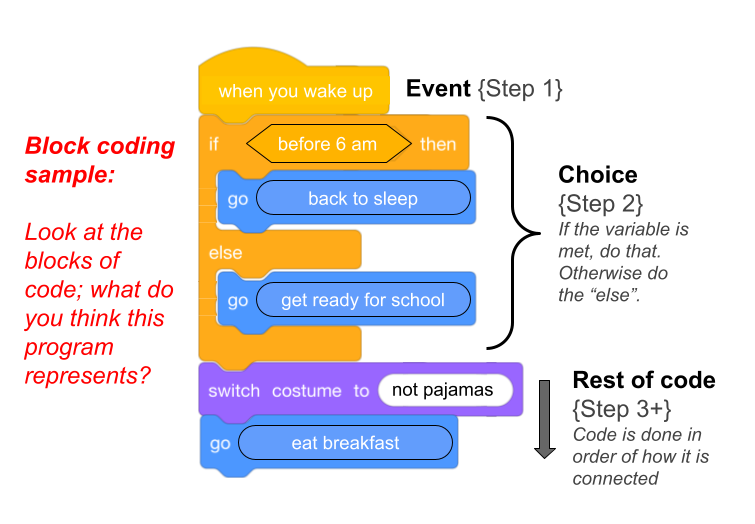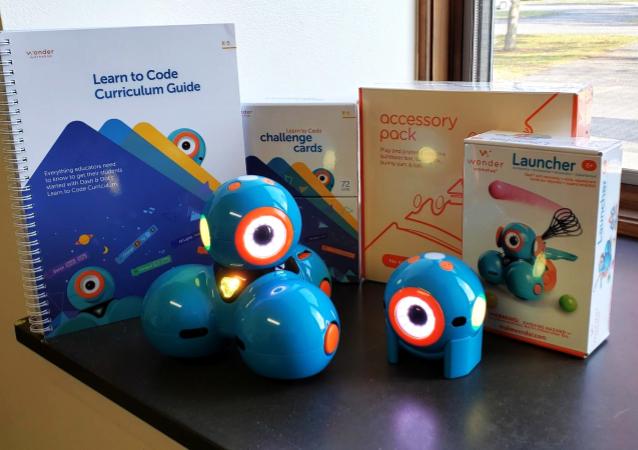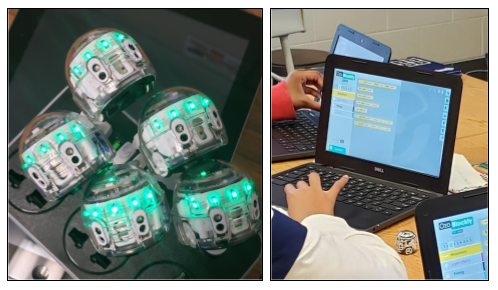If you haven’t practiced coding concepts before you can view our previous post about introducing beginning coding concepts in our Coding Concepts 101 post.
Coding can be a way to challenge students to think differently. As mentioned before, if a person can give and follow step-by-step directions they can code.
What is Block coding?
For beginning coders, some begin with a specific coding language (typing code) or start by using blocks of code (sometimes referred to as “Blockly”). Blockly coding creates “building blocks” of precreated code that the user can connect together to create their program.
Programs can be as simple or as complicated as desired. A simple example might be to have an icon change color when clicked. A more complicated example could be specifying what color the icon turns based on how many times the icon is clicked. (For example, if clicked 2 times, then turn the icon green; else if clicked turn it red.)
Below is a sample of block coding used to demonstrate a daily routine. Remember, if someone can create and follow directions they can learn to code!

How do you use Block coding?
- Start with an event block. (ie when the space bar is pushed…)
- Add any components that should (or should not) happen when the above event begins.
- Depending on what you are coding you can (examples below)
- Add sounds or movement
- Change color or scenary
- Add conditional code (if ____ happens then do ______)
- Depending on what you are coding you can (examples below)
- Test the code! (sometimes it will have a Run button or Test button)
Block Coding Activities:
There are many different coding sites/activities available for educational use; these are some that we have tried and recommend based on ease for use with beginners. The “gadgets” recommended are available to WWCSD staff only and can be requested by submitting a request on the Available Technology page.
Hour of Code
This is a popular option because it doesn’t require users to login. Each activity can be done in about an hour (hence the name). Teachers can sort activities by grade level, subject, or coding language (for Block coding, choose Block). Activities can be a lesson or self-paced depending on which you choose.
Another benefit to the Hour of Code is that there are a variety of activities from different coding sites/apps that you can preview before pursuing one in particular. Personally I liked the variety offered in the “Write your first computer program” activity for Grades 2+.
Code.org
Code.org is good for those looking for more than a single activity of coding and more of a course. There are different courses (based on age and skill level) that use block coding (as well as typed code later) to teach beginning coding concepts. The entire program is free to use although students will need to login to save their progress.
Dash and Dot* (coding robots)
*Click here to borrow (WWCSD only) 
Dash and Dot are a pair of robots that can be programed using a tablet app. We have iPads available to borrow when you are using them. One of the apps, called “Blockly” allows users to freely program Dash or Dot to do different commands (such as changing colors or speaking). Two teams can even program them to interact with each other.
Ozobots* (coding robots)
*Click here to borrow (WWCSD only)
Ozobots can be programmed two ways – with marker codes or with their online app. To program with Blockly, students will use the online platform to create their code first. After they will hold the Ozobot to their screen to transmit the code to the robot. Then they can test their code using the robot.
As a side note: we have found that device brightness may need to be adjusted up for the robot to accurately read the transmitted code.

You must be logged in to post a comment.